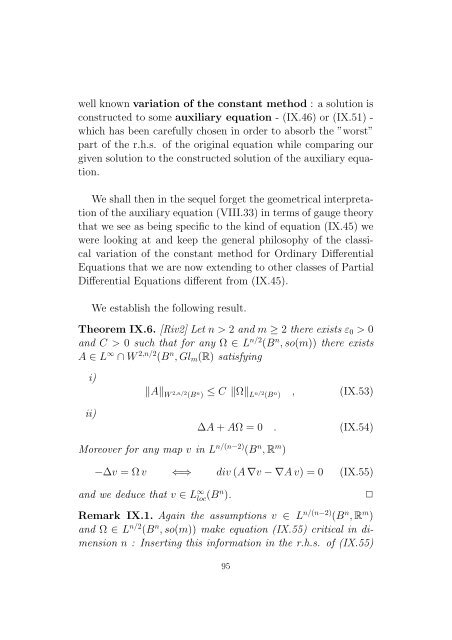Conformally Invariant Variational Problems. - SAM
Conformally Invariant Variational Problems. - SAM
Conformally Invariant Variational Problems. - SAM
You also want an ePaper? Increase the reach of your titles
YUMPU automatically turns print PDFs into web optimized ePapers that Google loves.
well known variation of the constant method : a solution is<br />
constructed to some auxiliary equation - (IX.46) or (IX.51) -<br />
which has been carefully chosen in order to absorb the ”worst”<br />
part of the r.h.s. of the original equation while comparing our<br />
given solution to the constructed solution of the auxiliary equation.<br />
We shall then in the sequel forget the geometrical interpretation<br />
of the auxiliary equation (VIII.33) in terms of gauge theory<br />
that we see as being specific to the kind of equation (IX.45) we<br />
were looking at and keep the general philosophy of the classical<br />
variation of the constant method for Ordinary Differential<br />
Equations that we are now extending to other classes of Partial<br />
Differential Equations different from (IX.45).<br />
We establish the following result.<br />
Theorem IX.6. [Riv2] Let n > 2 and m ≥ 2 there exists ε 0 > 0<br />
and C > 0 such that for any Ω ∈ L n/2 (B n ,so(m)) there exists<br />
A ∈ L ∞ ∩W 2,n/2 (B n ,Gl m (R) satisfying<br />
i)<br />
ii)<br />
‖A‖ W<br />
2,n/2<br />
(B n ) ≤ C ‖Ω‖ L<br />
n/2<br />
(B n ) ,<br />
∆A+AΩ = 0 .<br />
(IX.53)<br />
(IX.54)<br />
Moreover for any map v in L n/(n−2) (B n ,R m )<br />
−∆v = Ωv ⇐⇒ div(A∇v−∇Av) = 0 (IX.55)<br />
and we deduce that v ∈ L ∞ loc (Bn ).<br />
✷<br />
Remark IX.1. Again the assumptions v ∈ L n/(n−2) (B n ,R m )<br />
and Ω ∈ L n/2 (B n ,so(m)) make equation (IX.55) critical in dimension<br />
n : Inserting this information in the r.h.s. of (IX.55)<br />
95
















